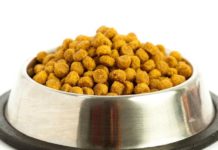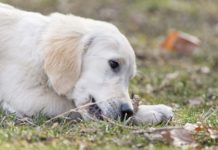
A movement in the dog world that seems to be growing in popularity is the return of the dog to his original, natural diet. The BARF – raw food diet, created by Dr Ian Billinghurst, is designed to provide dogs with a diet of raw meat, vegetables, and natural supplements in place of conventionally processed dog food. Raw feeders are opposed to commercial pet foods which they feel inappropriate for their animals, and claim that the raw diet provides many health advantages, such as fewer dental problems, strengthened immunity, and increased energy.
BARF is an acronym for biologically appropriate raw food, or bones and raw food diet. Proponents of this diet believe that because wild dogs ate raw meat, bones, offal, and sometimes vegetables and fruit, dogs should be eating the same foods now. Cooked bones are never fed, because cooked bones can easily splinter and become very dangerous. As a general rule, the raw diet consists of sixty percent raw meaty bones, such as chicken necks and wings, turkey necks and wings, beef brisket, pork feet and necks, and quail, rabbit, or duck. The remaining forty percent is divided into twenty-five percent for minced meat and offal (offal is organ meat like heart, liver, kidneys, or intestines), and fifteen percent crushed vegetables and fruit. Supplements like flax seed oil, cod liver oil, vitamins E and C, and yogurt are given as well.
Raw feeders refute claims from pet food companies that commercial pet food offers complete and nutritionally balanced meals for dogs. Some dry foods contain preservatives like BHA/BHT and ethoxyquin, which some speculate to be causes of certain diseases in dogs. Commercial foods also contain large amounts of grain that can cause allergic reactions in dogs, and are not part of a wild dog’s diet. Very high heats are used to process the commercial food, which can result in a loss of nutrients.
Strict guidelines exist for the switching of a dog from commercial pet food to a raw diet. Because there is such a drastic change in food, and because the dog may have only had dry kibble thus far in his life, the change must be very slow and gradual. If you are thinking about switching your animal, make sure you become informed about the exact nutritional needs of your dog, and are willing to commit a great deal of time to the preparation of his food. Raw meat must be stored carefully, and vegetables must be pureed or blended for the dog to properly absorb nutrients. Familiarize yourself with the Heimlich maneuver in case your dog chokes on a bone, and always watch your dog when he is eating. Also, be aware of your animal’s bowel movements, like the consistency and frequency, as a new member of the BARF diet may become constipated or develop diarrhea. Supplements are suggested to normalize the dog’s system.
Opponents of the raw diet exist as well; they feel that the purported benefits of a raw diet do not outweigh the risks. Although the risk of bacterial infection can be low when raw meat is properly handled, there is always the possibility that infection will occur. Salmonella can be contained in raw meats, and could pass through the dogs system and become an environmental contaminant in groundwater. In addition, raw meats sometimes contain parasites that can live through freezing, putting your dog at a greater risk of parasitic infection.
A controversy surrounds the raw food diet, and veterinarians seem to be on both sides of the fence. If you trust your vet, ask her opinion. Know however, that veterinarians can be influenced as retailers of pet foods to choose one side over the other. Many vets also receive grants and funding from pet food companies, and will tout the pet food company’s message as their own. Because the raw diet is relatively new to humans, there is still not enough adequate research to say completely which feeding method is better for your dog.
If you feel that your dog’s diet needs improvement, or your dog is suffering from a condition that you feel can be improved by a raw diet, carefully consider your options. Chances are that no one magical diet can cure all pet ills for good. The BARF – raw food diet is a return to a wild dog’s natural eating habits; however, studies of the diet benefits are insufficient at this time.





